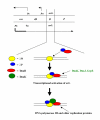Stress responses and replication of plasmids in bacterial cells
- PMID: 12076355
- PMCID: PMC115368
- DOI: 10.1186/1475-2859-1-2
Stress responses and replication of plasmids in bacterial cells
Abstract
Plasmids, DNA (or rarely RNA) molecules which replicate in cells autonomously (independently of chromosomes) as non-essential genetic elements, play important roles for microbes grown under specific environmental conditions as well as in scientific laboratories and in biotechnology. For example, bacterial plasmids are excellent models in studies on regulation of DNA replication, and their derivatives are the most commonly used vectors in genetic engineering. Detailed mechanisms of replication initiation, which is the crucial process for efficient maintenance of plasmids in cells, have been elucidated for several plasmids. However, to understand plasmid biology, it is necessary to understand regulation of plasmid DNA replication in response to different environmental conditions in which host cells exist. Knowledge of such regulatory processes is also very important for those who use plasmids as expression vectors to produce large amounts of recombinant proteins. Variable conditions in large-scale fermentations must influence replication of plasmid DNA in cells, thus affecting the efficiency of recombinant gene expression significantly. Contrary to extensively investigated biochemistry of plasmid replication, molecular mechanisms of regulation of plasmid DNA replication in response to various environmental stress conditions are relatively poorly understood. There are, however, recently published studies that add significant data to our knowledge on relations between cellular stress responses and control of plasmid DNA replication. In this review we focus on plasmids derived from bacteriophage lambda that are among the best investigated replicons. Nevertheless, recent results of studies on other plasmids are also discussed shortly.
Figures



References
-
- Helinski DR, Toukdarian A, Novick RP. Replication control and other stable maintenance mechanisms of plasmids. In: Neidhardt FC, Curtiss III R, Ingraham J, Lin ECC, Low KB, Magasanik B, Reznikoff WS, Riley M, Schaechter M, Umbarger H, editor. Escherichia coli and Salmonella: cellular and molecular biology. Washington DC, American Society for Microbiology; 1996. pp. 2295–2324.
-
- Chattoraj DK. Control of plasmid DNA replication by iterons: no longer paradoxical. Mol Microbiol. 2000;37:467–476. - PubMed
-
- Del Solar G, Espinosa M. Plasmid copy number control: an ever-growing story. Mol Microbiol. 2000;37:492–500. - PubMed
-
- Gerdes K, Moller-Jensen J, Jensen RB RB. Plasmid and chromosome partitioning: surprises from phylogeny. Mol Microbiol. 2000;37:455–466. - PubMed
LinkOut - more resources
Full Text Sources

